US Postal Service Mail
| Mail Pieces | Addressing | Fonts | Enclosures |
| Envelopes | Class Of Mail | Endorsements | Express Mail Service |
| International Mail | Reply Mail | Large Mailings | Personal Mail |
Mail Pieces
POSTCARDS, LETTERS, LARGE ENVELOPES/FLATS & PACKAGES
There are three standards for identifying the category of a mailpiece:
- 1. Weight,
- 2. Physical Size, and
- 3. Thickness.
The Post Office usually has at least one rate change a year-depending on weight in ounces. Also, an item once considered a letter is now classified as a letter, flat or package--based on its thickness. Thickness is measured with the item lying on a flat surface--NOT pressed down.
A POSTCARD is larger than 3½” x 5”, smaller than 4¼” x 6”, between 0.007” and 0.016” and weighs less than one ounce.
A LETTER is usually a #10 envelope with correspondence. It is larger than 3½” x 5”, smaller than 6 ⅛” high x 11 ½” long, be LESS than ¼” thick and weigh less than 3½ ounces.
A FLAT is a large envelope with correspondence. It is smaller than 12” high x 15” long, must be LESS than ¾” thick and weigh less than 13 ounces.
Tips for saving postage:
1. If a #10 envelope is over thick (over ¼”) it will be classified as a “flat” and postage is twice as much as the same item folded in half and placed in a 6” x 9” envelope at the letter rate. 2. A letter can go up to 6 ⅛” x 11 ½”. An envelope 6 3/16” x 11 ½” is a flat and postage is twice as much. Is the extra 1/16” really needed and worth the additional postage?

AddressingTop
The following is recommended in the sequence and position indicated for addressing to insure efficient handling and delivery by the US Postal Service.

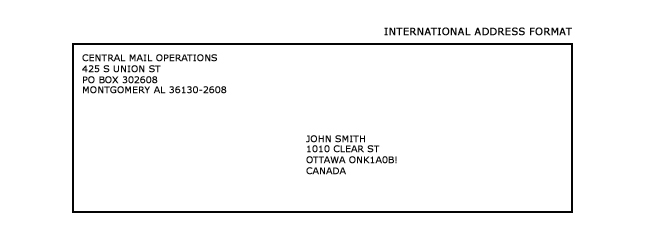
- CAPITALIZE EVERYTHING IN THE ADDRESS
- Use 2-letter state abbreviations (see Addressing Standards in State Agency Mail Information section)
- Eliminate all punctuation (except the hyphen between ZIP Code and plus four)
- Use appropriate abbreviations (see Addressing Standards in State Agency Mail Information section), City names are NEVER Abbreviated
- Use ZIP + 4 Codes
Make sure the place where you want the mail delivered appears on the line immediately above the city, state and ZIP code line. Never put the APT# or Lot# on the line just above the city and state (See Exhibit 2).
If both the street address and the P O Box are on the same line, the mail piece will be delivered to the P O Box. Example: in Exhibit 2, you will notice our physical address and our PO BOX DELIVERY ADDRESS.
ADDRESS PLACEMENT
- Envelopes Placement of the address on the face of an envelope should conform to USPS specifications as shown on (Exhibit 4).
- Labels Labels for use on parcels, packages or large envelopes must be addressed according to the recommended format in (Exhibit 2). Improperly prepared labels will be returned to you for correction and/or completion. Labels that are applied must be parallel to the bottom edge of the envelope to be processed by the USPS on automation equipment.
FontsTop
FONT STYLE SHEET
ADDRESSING 'BEST PRACTICES' AND FORMAT
- Type or machine-print all address information.
- Make sure print is clear and sharp.
- Ensure address characters don't touch or overlap.
- Black ink on a white background is best.
- Maintain a uniform left margin.
- Use upper-case letters
- Omit all punctuation
- Include floor, suite and apartment numbers whenever possible.
- Put the city, state and ZIP Code or ZIP + 4 code in that order on the last line. If there's not enough room, you can put the ZIP Code or ZIP + 4 code alone on the bottom line.
- Use standard two-letter state abbreviations.
- When using window envelopes, make sure the complete address is always visible, even when the insert moves.
- Leave one or two spaces between words and between the state abbreviation and ZIP Code or ZIP + 4 code.
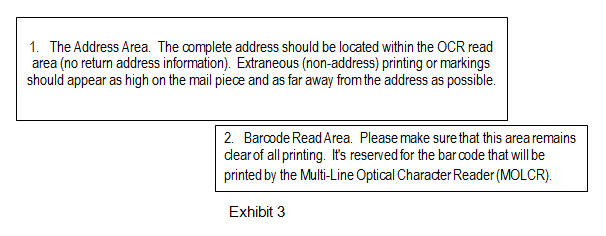
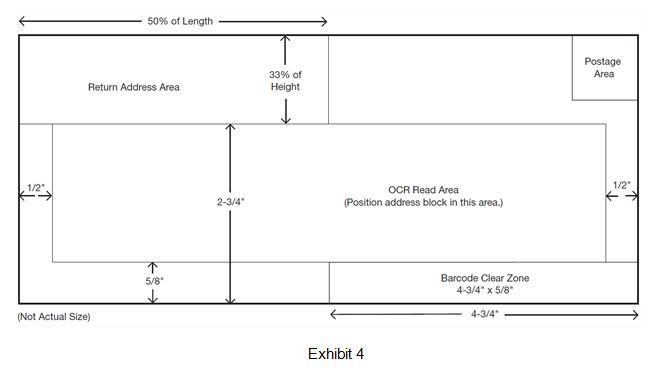
STANDARD ADDRESS ABBREVIATIONS
See Addressing Standards in State Agency Mail Information section and identified appendix:
- States & Directional (Appendix B)
- Street Designators (Appendix C)
- County, State & Local Highways (Appendix F)
EnclosuresTop
Correspondence
Mail of any kind for transport by the US Postal Service should be enclosed in an appropriate envelope or parcel and sealed. The types of enclosures determine the mailing classification.
Non-mailables
The following are samples of non-mailables in envelopes:
Paper Clips, Metal Pieces, Glass Chips, Sand
In addition to jamming and/or damaging the mailing machines, these items can also cause serious injury to Mail Center employees.
The following are also classified as non-mailables and will be returned to sender:
Envelopes and Cards if pieces are less than:
3 1/2" in height
or
5" in length
or
.007" in thickness (thickness of a post card)
All foreign countries also impose various restrictions depending on country and item(s) being mailed. It is recommended that when mailing questionable items to US or foreign destinations, the mailer should call Mail Services for assistance.
Window Envelope Enclosures
Enclosures must be designed so that the address appears in the window and should not be stapled to prevent movement of the address from window view. If the addressed enclosure does not properly fit the window, use an envelope without a window.
EnvelopesTop
Sizes and Types
The size of the envelope should properly accommodate the contents. In the US Postal System there are two categories of envelopes: letter size and flats.
- Letters, non-letters and bar-coded flats are rated differently by the USPS. To assure the best rate, call Mail Services for size and rates before preparing the mail piece. Use light colored envelopes for legibility and please avoid brilliant colors.
Letter Size
- Letter size mail must be rectangular in shape for automated processing by USPS.
- To ensure prompt and efficient processing of First-Class mail, it is recommended that all envelopes and cards.
- a.Have an aspect ratio (length divided by height) between 1 to 1.3 and 1 to 2.5 inclusive. See Mail Services for envelope template if you are not sure of sizing.
- b.Be sealed or secured on all four edges so that they can be handled by machines.
- c.Meet the following dimensions for automated processing by USPS:
- Height 3 1/2" Min 6 1/8" Max
- Length 5" Min 11 1/2" Max
- Thickness* .007 Min 1/4" Max
- * NOT Compressed
- Card Stock should not exceed .016"
Note: Maximum thickness for automated processing is 1/4". Mail that does not meet automated processing size may not qualify for discounted rates. Letter size envelopes (up to 6 1/8" x 11 1/2") over 1/4" thick will be mailed at full price plus a nonmachinable surcharge
Non-Letter (Flats)
Non letter size envelopes are larger than the maximum letter size, but not larger than 12" high by 15 3/4" long and 1 1/4" thick.
International Letter Size Envelopes
Mail going to foreign countries should be banded separately and marked "FOREIGN MAIL". Complete name, addresses, and zip must be used or the USPS will not accept them. The Country in all capital letters, must be on the last line of the address.
Plain White or Manila
Either envelope can be used for first class or standard mail. However, only white envelopes provide sufficient print contrast for our sorter to recognize the characters and address.
Padded
These envelopes contain a cushioned lining to provide a degree of safety for mailing small and fragile merchandise.
Priority
Should be used for First-Class mail weighing over 13 ounces and up to 70 pounds, or any other mail under 13 ounces requiring expedited delivery. Priority Mail provides two-day service between major metropolitan areas.
Class Of Mail, Additional Fees & USPS Special ServicesTop
CLASSES OF MAIL
First Class Mail
Any mailable matter may be mailed as First-Class Mail. The following examples are considered First-Class matter and must carry postage at First-Class or Priority Mail rates.
- 1. Matter wholly or partially handwritten or typewritten (including identical copies prepared by automatic typewriter), originals or carbons, invoices, (except when accompanying the matter to which they relate), postal cards, post cards.
- 2. Matter sealed against postal inspection. "Standard" mail can be sealed and opened by the USPS for inspection.
- 3. Bills and statements of account.
- 4. Price lists with written-in figures changing items or prices.
- 5. Blank printed forms filled out in writing, including canceled or un-canceled checks.
- 6. A computer printout may or may not be First-Class matter. It depends on the content. Contact Mail Services for additional information.
- 7. If you are not sure if it is First-Class, ask us!
- 8. Discounted presort rates are available for 500 or more pieces.
Priority Mail
All First-Class mail exceeding 13 ounces and not exceeding 70 pounds is considered priority mail and at the option of the mailer, any mail weighing 13 ounces or less.
Use Priority Mail when 2 to 3 day service is desired.
Use Flat Rate Priority Envelopes when possible. These free envelopes allow any weight of material for the 1-pound rate. DO NOT use tape to seal the envelope.
Note: Priority Mail is a 2 day service between 64 major markets i.e. Atlanta to Dallas or Chicago to New York. When using Priority Mail we recommend use of priority envelopes available at no charge from your local Post Office.
Standard Mail
The following is considered Standard Mail Matter:
- Circulars
- Booklets
- Merchandise
- Photographs
- Catalogs
- Newsletters
- Product Samples
- Printed Matter
- Advertising
To qualify for Standard Mail rates, you must mail at least 200 pieces or a mailing that weighs 50 pounds. Each piece of Standard Mail must be less than 16 ounces. Anything heavier must be mailed as Package Services or Priority mail.
Package Services
The following is considered Package Services Matter:
- Packages or Parcels
- Library Materials
- Bound Printed Matter
- Sound Recordings
- Merchandise
- Computer Media
- Books
- Films
- Video Tapes
Each piece of Package Service Mail must not exceed 70 pounds in weight and a maximum size of 130" in length and girth combined. All oversized pieces, regardless of actual weight, will be charged at an "oversized" rate based on zone or entry, which is a higher rate than the 70-pound rate. A number of quantity discounts are available for bulk mailings. Call Central Mail Operations.
There are four sub-categories of Package Service Mail that might save postage. They are:
- Media Mail (Previous "Book Rate", but not just for books)
- Library Mail
- Bound Printed Matter
- Parcel Post
Call Central Mail Operations for qualifying items and postage rates.
ADDITIONAL FEES
The cost of mailing varies with each classification.
Oversize Underweight Mail
First-Class, Standard Mail and International Letter-Post Mail weighing one ounce or less is non-standard* if it exceeds any of the following size standard limits:
6 1/8" in height
or
11 1/2" in length
or
1/4" in thickness
or
Its aspect ratio (length divided by height) does not fall between 1 to 1.3 and 1 to 2.5 inclusive.
Non-Standard Mail
There is an additional charge on each piece of mail that is found to be non-standard. In addition, pieces which are less than the following dimensions are non-mailable in the US Postal Service and will be returned to you.
3 1/2" in height
or
5" in length
or
.007" in thickness (thickness of a postcard)
Special Services
Accountable Mail includes all Certified, Registered and Insured mail. Do not place critical mail for these categories in the internal mail.
Certified Mail - provides you with a mailing receipt and a record of delivery is maintained at the recipient's post office. A return receipt provides you with proof of delivery and can be obtained for an additional fee. Certified mail service is available only for First-Class Mail. No insurance coverage is provided. A numbered label and completed receipt must be affixed. These labels can be obtained from mail services.
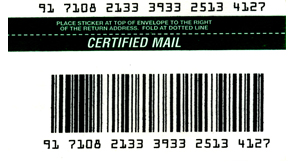
Registered Mail - the registered mail system is designed to provide added protection for valuable mail. Postage insurance may be purchased to cover articles valued up to $25,000. Registered mail is the most secure mail the Postal Service offers. It incorporates a system of receipts to monitor registered articles from the point of acceptance to delivery. Return receipt and restricted delivery services are available for additional fees. Added security may delay delivery by 24 - 48 hours.
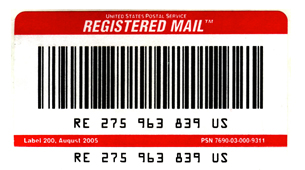
Return Receipts PS Form 3811 - A return receipt is your proof of delivery. It is available for insured mail, certified, registered and domestic Express mail shipments. The return receipt identifies the article number, who signed for it and the date it was delivered. It is not necessary to utilize a return receipt on all certified or registered mailings. Be certain to identify your department with provider code on the return side.

Tracking - Certified and registered mail cannot be tracked until an attempt of delivery is made. Go to USPS.COM to track and confirm.
USPS Tracking Label 400 -
EndorsementsTop
The endorsements are the same for all classes of mail, but the treatment and cost differ by class of mail. Use of an ancillary service endorsement on a mailpiece obligates the mailer to pay any applicable charges for forwarding, return, and separate address notification charges.
An endorsement must stand out clearly against its background. Brilliant-colored envelopes and reverse printing are not permitted. There must be a 1/4-inch clear space around all sides of the endorsement. The endorsement and return address must read in the same direction as the delivery address.
TYPE, SIZE AND PLACEMENT
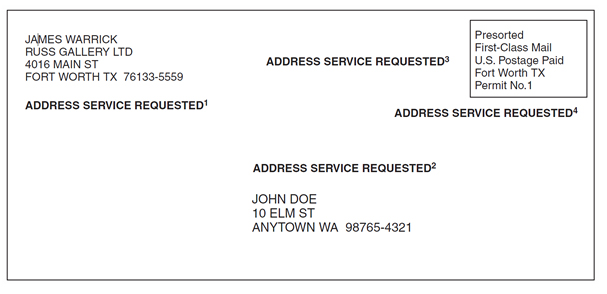
Endorsements must be at least 8-point type and appear in one of the following locations: directly below the return address, directly above the delivery address, directly to the left of the postage area and below any rate marking or directly below the postage area and below any rate marking.

Express Mail ServiceTop
Provides next day or second day service to all major markets in the United States. Express Mail can weigh up to 70 lbs., and is delivered 7 days a week at no extra charge.
Do not place critical mail for this service in the internal mail system.
Express mail offers a variety of service options to meet your mailing needs. The following is a list of these options. Contact the Mail Center for further details.
- Post Office to Addressee
- Post Office to Post Office
Domestic Overnight Delivery is guaranteed by the US Postal Service (to most locations), and provides for a full postage refund if the item is not delivered on time.
International MailTop
Most items are mailable to foreign countries. However, there are certain restrictions. It is important that mailers contact Mail Services to determine the proper classification and documentation required.
If customs regulations are not followed and documentation is not exact, the item will be impounded by customs until the addressee makes arrangements for clearance and the payment of whatever duties required for the release of the item. Custom rules apply the same whether mail is sent by USPS or other couriers.
The last line of any foreign address should be the country name spelled out in capital letters, in English.
Reply MailTop
All business reply postage and handling charges are billed back to using departments. When you decide to design any business reply envelope or card, please call the Montgomery USPS Business Mail Entry Unit (BMEU) Manager at (334) 244-7653 for the proper format. Your department provider code must appear in the return address for billing.
BUSINESS REPLY MAIL (BRM) BRM service enables mailers to receive First-Class mail by paying postage only on the mail which is returned. We guarantee payment of the appropriate First-Class postage plus a handling charge per piece. A special return zip+4 will be assigned.
METER REPLY MAIL In some instances Meter Reply Mail is the best method. For information, contact Central Mail Operations.
COURTESY REPLY MAIL Pre-printed envelopes with special formats are available. Mailers returning these to us must prepay the postage. A special zip+4 will be assigned.
CONTACT CENTRAL OPERATIONS prior to designing or printing any BUSINESS REPLY mail pieces to insure the most cost-efficient method.
Large MailingsTop
Before producing a large or specialized mailing, include Central Mail Operations in your mailing arrangements to ensure your mailing program is timely and cost effective.
Advance notice is required to effectively handle and process large or specialized mailings. Large mailings are considered any mailing consisting of 2,500 or more pieces.
Personal MailTop
PERSONAL MAIL - INCOMING AND OUTGOING
Personal mail should not be sent through Central Mail Operations. Central Mail Operations is for official state business only.